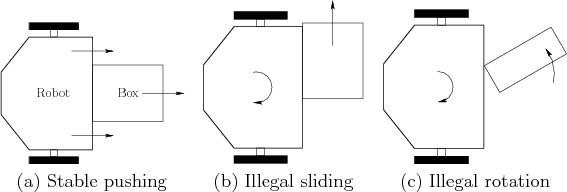
Next: 13.1.3.2 Flying an airplane Up: 13.1.3 Other Examples of Previous: 13.1.3 Other Examples of
Imagine using a differential drive robot to push a box around on the floor, as shown in Figure 13.7a. It is assumed that the box is a convex polygon, one edge of which contacts the front of the robot. There are frictional contacts between the box and floor and also between the box and robot. Suppose that the robot is moving slowly enough so that dynamics are insignificant. It is assumed that the box cannot move unless the robot is moving. This prohibits manipulations such as ``kicking'' the box across the room. The term stable pushing [12,671,681] refers to the case in which the robot moves the box as if the box were rigidly attached to the robot.
 |
As the robot pushes the box, the box may slide or rotate, as shown in
Figures 13.7b and 13.7c,
respectively. These cases are considered illegal because they do not
constitute stable pushing. What motions of the robot are possible?
Begin with the configuration transition equation of the differential
drive robot, and then determine which constraints need to be placed on
![]() to maintain stable pushing. Suppose that (13.17)
is used. It is clear that only forward motion is possible because the
robot immediately breaks contact with the box if the robot moves in
the opposite direction. Thus,
to maintain stable pushing. Suppose that (13.17)
is used. It is clear that only forward motion is possible because the
robot immediately breaks contact with the box if the robot moves in
the opposite direction. Thus, ![]() must be positive (also, to fit the
quasi-static model,
must be positive (also, to fit the
quasi-static model, ![]() should be small enough so that dynamical
effects become insignificant). How should the rotation rate
should be small enough so that dynamical
effects become insignificant). How should the rotation rate ![]() be constrained? Constraints on
be constrained? Constraints on ![]() depend on the friction model
(e.g., Coulomb), the shape of the box, and the particular edge that is
being pushed. Details on these constraints are given in
[671,681]. This leads to an interval
depend on the friction model
(e.g., Coulomb), the shape of the box, and the particular edge that is
being pushed. Details on these constraints are given in
[671,681]. This leads to an interval
![]() , in which
, in which ![]() and
and ![]() , and it is required that
, and it is required that
![]() . This combination of constraints produces a motion
model that is similar to the Dubins car. The main difference is that
the maximum steering angle in the left and right directions may be
different.
. This combination of constraints produces a motion
model that is similar to the Dubins car. The main difference is that
the maximum steering angle in the left and right directions may be
different.
To apply this model for planning, it seems that the C-space should be
![]() because there are two
rigid bodies. The manipulation planning framework of Section
7.3.2 can be applied to obtain a hybrid system and
manipulation graph that expresses the various ways in which the robot
can contact the box or fail to contact the box. For example, the
robot may be able to push the box along one of several possible edges.
If the robot becomes stuck, it can change the pushing edge to move the
box in a new direction.
because there are two
rigid bodies. The manipulation planning framework of Section
7.3.2 can be applied to obtain a hybrid system and
manipulation graph that expresses the various ways in which the robot
can contact the box or fail to contact the box. For example, the
robot may be able to push the box along one of several possible edges.
If the robot becomes stuck, it can change the pushing edge to move the
box in a new direction.
Steven M LaValle 2012-04-20